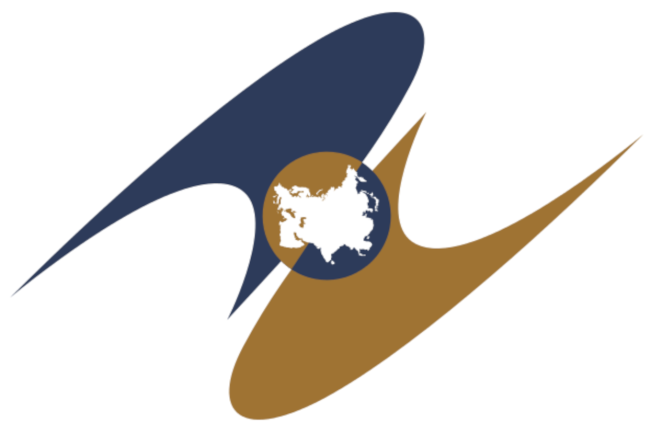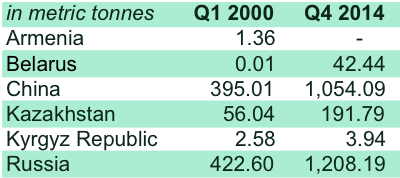China’s Silk Road Economic Project Will Include Gold
The Chinese government seems to be very keen on developing the New Silk Road Economic Belt as fast as possible; an initiative, said to be designed by President Xi Jinping himself, that will increase economic cooperation in the wide Eurasian region. At a stunning speed China and Russia take the lead in strengthening ties in the area. For the wind down of the US dollar hegemony the Silk Road economic project is an important tool. As part of this project two clubs are rapidly developing as we speak, the Asian Infrastructure Investment Bank (AIIB) and the Eurasian Economic Union (EEU). Additionally, China is incorporating gold into the Silk Road project.
The Asian Infrastructure Investment Bank
The AIIB is an international financial institution proposed by China in 2013 to finance infrastructure projects in Asia. The Chinese government has been frustrated with the slow pace of reforms in established institutions like the IMF and World Bank, which are dominated by the US. China’s rapid economic growth in recent years has made them pursuing a greater input in these institutions, but the US has neglected to honor these requests appropriately, forcing China to launch its own institutions.
Despite the US has been pressuring its allies from signing up as AIIB prospective founding members only Japan obeyed, signaling a demise of US power and failing US foreign policy. In a milestone event many western countries have submitted for membership in March and April 2015, amongst others the UK, Switzerland, Sweden, Spain, Portugal, Norway, the Netherlands, Italy, Germany, France, Finland, Denmark, Australia and Israel. The AIIB articles of agreement are expected to be completed by the end of 2015.
China is now playing multiple games at the same time by developing the AIIB and concurrently pressuring the IMF to reform. One of China’s goals is for the renminbi to be included into the IMF’s basket of currencies the Special Drawing Right (SDR). On April 30, 2015, the IMF’s Director Of The Communications Department, Gerry Rice, stated in a press briefing about the SDR review “Yes, the work has begun” (see this video at 28:15). The first IMF board meeting on the SDR review originally scheduled in May 2015, has been “deferred, because the work is underway” (see the same video at 31:30).
The Eurasian Economic Union
The President of Kazakhstan, Nursultan Nazarbayev, first suggested the idea of creating a regional (Eurasian) trading bloc during a speech at Moscow State University In 1994. Afterwards Belarus, Russia and Kazakhstan formed a free trade zone, which turned into a customs union, followed by a single economic space, finally reaching an economic union (the EEU) on May 29, 2014, when an agreement was signed by the Supreme Eurasian Economic Council in Astana, Kazakhstan.
Worth noting is that according to Pravda.ru Nazarbayev is of the opinion the US dollar is an illegal and non-competitive means of payment, “the world currency was not de jure legitimate because it was never adopted by any communities or organizations. There is no such international law,… the world currency market is not a civilized market, as the system of world currency issuance is not being controlled”. Nazarbayev believes the world is heading towards a new monetary system, from “defective capitalism” to “the new capitalism that would be based on a non-defective currency.” Chinese President Xi Jinping visited Kazakhstan in September 2013 where he raised the initiative of the Silk Road Economic Belt at the Nazarbayev University. In March this year China and Kazakhstan signed 33 deals on industrial capacity cooperation.
The EEU is aggressively expanding; its latest official members are Armenia and Kyrgyzstan. By looking at the EEU flag, that displays the whole of Asia, it doesn’t take a lot of imagination to expect they’ll continue expanding. Turkey has mentioned it likes to join and there are talks with Vietnam to form a free trade area.
Russian news outlet RT has disclosed that Vladimir Putin and Xi Jinping have signed a decree on cooperation in tying the development of the EEU with the Silk Road economic project. “The integration of the Eurasian Economic Union and Silk Road projects means reaching a new level of partnership and actually implies a common economic space on the continent," Putin said. Furthermore, columnist for Russian news outlet Sputnik, Pepe Escobar, stated, “What we have here, above all, is the China-led New Silk Road directly connecting with the Russia-led EEU. China and the EEU are bound to set up a free trade zone”. The EEU could potentially grow into a very significant power bloc.
More from Escobar:
The always-evolving strategic partnership is not only about energy – including the possibility of Chinese-controlled stakes in crucial Russian oil and gas projects – and the defense industry; it’s increasingly about investment, banking, finance and high technology.
…The partnership’s reach is extremely wide, from Russia-China cooperation within the Shanghai Cooperation Organization (SCO) to the Russia-China stake in the new BRICS development bank, and to Russian support to the Chinese-led Asian Infrastructure Investment Bank (AIIB) and the Silk Road Foundation.
…Beijing and Moscow, along with the other BRICS nations, are fast moving to trade independently of the US dollar, using their own currencies. In parallel, they are studying the creation of an alternative SWIFT system – which will necessarily be joined by EU nations, as they are joining the AIIB.
There have also been talks for an EEU joint currency titled Altyn, which refers to an ancient currency that used to circulate in Eurasia. In the past Altyn has never been minted in gold, although in Turkic, a language family spoken in Eurasia, Altyn does mean Gold.
Make sure English captions are turned on in the next video clip from Russian television about Altyn.
Belarus, Kazakhstan, Russia and China have all substantially increased their official gold reserves since the first quarter of 2000. Kyrgyzstan to a lesser extent and Armenia has currently no official gold reserves.
“One Belt One Road” And Gold.
It was first disclosed by Albert Cheng, Managing Director of the World Gold Council, in a speech at the Dubai Multi Commodities Centre April 12, 2015; China has ambitions to include gold in the One Belt One Road (OBOR) economic project. From one of Cheng’s slides we can read:
China Gold Market – the next 10 years – Integrate gold cooperation into One Belt, One Road
– Mr. Xu Luode, President of Shanghai Gold Exchange and a National People’s Congress (NPC) delegate proposed that to integrate gold market development into the strategic development plan of “OBOR” to the NPC & CPPCC ended in mid-March, 2015.
– His proposal suggested that cooperation and development mechanism to involve major gold producers/users along the OBOR.
– This initiative to be led by People’s Bank of China, Ministry of Foreign Affairs, National Development and Reform Commission, Ministry of Commerce and other related ministries, should be developed by leveraging the Shanghai Gold Exchange as the trading hub, and be integrated into the “OBOR” plan.
– Related specialized plans and supportive policies will also be developed to balance the regional developments in China and accelerate the interconnection with countries along the routes.
At first I was a bit skeptical towards these statements; when the Xi Jinping launches new projects all the subordinate bureaucrats need to show that their respective departments will contribute to this. Previously the Shanghai Gold Exchange (SGE) has been very clear about its international ambitions with the SGE International Board, but before any of this is realized let’s not copy-paste every idea they put out, I thought.
However, the first signs of cooperation in the gold industry along OBOR are reality, time to pay attention. On May 11, 2015, China’s largest gold mining company, China National Gold Group Corporation (CNGGC), announced it has signed an agreement with Russian gold miner Polyus Gold to deepen ties in gold exploration. The cooperation will include mineral resource exploration, technical exchanges and materials supply.
“China’s Belt and Road Initiative brings unprecedented opportunities for the gold industry. There is ample room for cooperation with neighboring countries, and we have advantages in technique, facilities, cash, and talents," said Song Xin, General Manager of CNGGC and President of the China Gold association. Song Yuqin, Deputy General Manager of the Shanghai Gold Exchange has stated, “Asians have a tradition of collecting gold. The gold trade is expected to become a significant component of transactions by ‘Belt and Road’ countries."
Popular Blog Posts by Koos Jansen
 China’s Secret Gold Supplier is Singapore
China’s Secret Gold Supplier is Singapore
 Audits of U.S. Monetary Gold Severely Lack Credibility
Audits of U.S. Monetary Gold Severely Lack Credibility
 China Gold Import Jan-Sep 797t. Who’s Supplying?
China Gold Import Jan-Sep 797t. Who’s Supplying?
 The Gold-Backed-Oil-Yuan Futures Contract Myth
The Gold-Backed-Oil-Yuan Futures Contract Myth
 Estimated Chinese Gold Reserves Surpass 20,000t
Estimated Chinese Gold Reserves Surpass 20,000t
 Did the Dutch Central Bank Lie About Its Gold Bar List?
Did the Dutch Central Bank Lie About Its Gold Bar List?
 PBOC Gold Purchases: Separating Facts from Speculation
PBOC Gold Purchases: Separating Facts from Speculation
 U.S. Mint Releases New Fort Knox Audit Documentation
U.S. Mint Releases New Fort Knox Audit Documentation
 China Net Imported 1,300t of Gold in 2016
China Net Imported 1,300t of Gold in 2016
 Why SGE Withdrawals Equal Chinese Gold Demand and Why Not
Why SGE Withdrawals Equal Chinese Gold Demand and Why Not




 Koos Jansen
Koos Jansen












